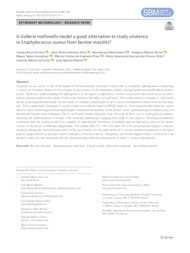Is Galleria mellonella model a good alternative to study virulence in Staphylococcus aureus from bovine mastitis?
Is Galleria mellonella model a good alternative to study virulence in Staphylococcus aureus from bovine mastitis?
Author(s): SILVA, J. R. da; SILVA, J. F. M.; PEREIRA, M. F.; TORRES, A. R.; GONÇALVES, M. S.; PRATA, M. C. de A.; BRITO, M. A. V. P. e; COSTA, G. M. da; RIBEIRO, J. B.
Summary: Staphylococcus aureus is one of the agents of bovine mastitis of hardest control due to a complex pathogenesis comprising a variety of virulence factors, which ensures its persistence in the mammary gland, causing significant health and economic losses. Therefore, understanding the pathogenesis of this agent is imperative. Galleria mellonella has stood out as an invertebrate animal model for the study of infectious diseases that affect several hosts. This work aimed to evaluate G. mellonella larvae as an experimental model for the study of virulence phenotypes in an S. aureus population isolated from bovine mastitis. Thirty genetically divergent S. aureus strains were chosen based on PFGE analysis. After experimental infection, larvae survival rates, bacterial growth in hemolymph, melanization intensity of the dorsal vessel, and histological characteristics of the infected tissues were evaluated. The G. mellonella model showed a clear diversity in the S. aureus pathogenicity pattern, allowing the differentiation of strains with virulence phenotypes ranging from high to low degrees. Histological analysis confirmed that the strains tested were capable of inducing the formation of nodules and melanization spots in the dorsal vessels of the larvae in different magnitudes. The strains 16S-717, 19C-828, and 31S-1443 presented the highest virulence intensity among the bacteria tested and will be used further for the generation of S. aureus mutant populations to prospect genetic targets aimed to develop control strategies of bovine mastitis. Altogether, our results suggest that G. mellonella is an attractive and low-cost animal model for characterizing virulence phenotypes of large S. aureus populations.
Publication year: 2024
Types of publication: Journal article
Unit: Embrapa Dairy Cattle
Observation
Some of Embrapa's publications are published as ePub files. To read them, use or download one of the following free software options to your computer or mobile device. Android: Google Play Books; IOS: iBooks; Windows and Linux: Calibre.
Access other publications
Access the Agricultural Research Database (BDPA) to consult Embrapa's full library collection and records.
Visit Embrapa Bookstore to purchase books and other publications sold by Embrapa.

